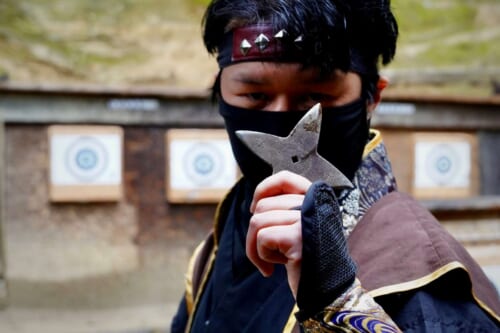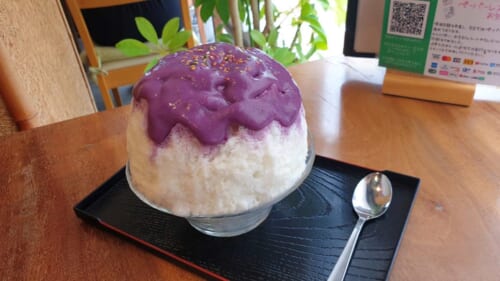Though the food is typically light and healthy, there are many instances in traditional Japanese cuisine you will encounter a snack that is dense enough to constitute a meal in and of itself. Such is the case with Ikinari dango, an treat consisting of raw sweet potato steamed while wrapped in mochi (rice dumplings). Perfect for fall and winter, Ikinari dango is typically served warm, and is every bit as heavy as it sounds. The Kumamoto speciality is bound to keep you pleasantly satiated while containing the bare minimum of processed sugars that you could ask for from such a substantial treat.
 Kumamoto’s specialty Ikinari dango can be translated literally as “sudden dumplings.” Though you will inevitably have at least one friend who elicits groans in feigned surprise every time he sees them, the true meaning is derived from the fact that these dumplings are easily prepared. The dango contain a total sum of about three ingredients, making them simple to put together for sudden and unexpected houseguests (barring you know how to handle mochi flour).
Kumamoto’s specialty Ikinari dango can be translated literally as “sudden dumplings.” Though you will inevitably have at least one friend who elicits groans in feigned surprise every time he sees them, the true meaning is derived from the fact that these dumplings are easily prepared. The dango contain a total sum of about three ingredients, making them simple to put together for sudden and unexpected houseguests (barring you know how to handle mochi flour).
 The rice flour Ikinari dango may come in several different varieties, although typically these do not vary much in terms of contents. By definition, they contain a wedge of steamed satsumaimo (yellow sweet potato), as well the occasional dollop of anko (read bean paste) to enrich the sweetness even further, which is then wrapped inside the mochi rice dumpling. You will likely see several different and colorful varieties of Ikinari dango. However, this correlates to the flavoring of the mochi, rather than the filling. Some popular flavors include purple yam, sakura, matcha, and chestnut. Dango are a staple of Kumamoto’s festivals, whether during the moon-viewing, cherry blossom season, or Mizu Akari.
The rice flour Ikinari dango may come in several different varieties, although typically these do not vary much in terms of contents. By definition, they contain a wedge of steamed satsumaimo (yellow sweet potato), as well the occasional dollop of anko (read bean paste) to enrich the sweetness even further, which is then wrapped inside the mochi rice dumpling. You will likely see several different and colorful varieties of Ikinari dango. However, this correlates to the flavoring of the mochi, rather than the filling. Some popular flavors include purple yam, sakura, matcha, and chestnut. Dango are a staple of Kumamoto’s festivals, whether during the moon-viewing, cherry blossom season, or Mizu Akari.
Those intent on having the most authentic Ikinari dango experience would be best advised to visit Suizenji Park – the stalls outside this park and zen garden are where the sweets were said to have first been invented. You can purchase the dango without admission to the park, in the shopping area just before the garden. The second most popular purveyor of Ikinari dango is among the stalls upon entering Kumamoto Castle. The clerks here are always happy to teach you about the dumplings as they welcome you to the castle. In summer, this location also sells them iced.
 For fans of Ikinari dango who are looking to buy them in bulk, off the beaten trail lays one of the best locations for buying takeaway dango. Ki Ki Ya is a Japanese sweets store and café located just southwest of downtown Kumamoto’s historic Kawaramachi district. Recognizable from their outdoor steamer, they offer a variety of Ikinari Dango, as well as other artisan, traditional Japanese sweets. They come in five flavors, and are available freshly steamed or packaged for home preparation.
For fans of Ikinari dango who are looking to buy them in bulk, off the beaten trail lays one of the best locations for buying takeaway dango. Ki Ki Ya is a Japanese sweets store and café located just southwest of downtown Kumamoto’s historic Kawaramachi district. Recognizable from their outdoor steamer, they offer a variety of Ikinari Dango, as well as other artisan, traditional Japanese sweets. They come in five flavors, and are available freshly steamed or packaged for home preparation.  Those who have access to a kitchen and are feeling particularly ambitious may also wish to make their own Ikinari dango. In this case, the Kokai Bashi fruit market just north of Fujisaki Shrine offers some of the cheapest produce in the city. Satsumaimo and rice flour for mochi are found year-round at this market. If you find yourself losing resolve halfway through, merchants often sell their own home made sweets such as Ikinari dango here as well. Regardless of where and how suddenly you decide to eat it, Ikinari dango is a culinary experience not to be overlooked in Kumamoto.
Those who have access to a kitchen and are feeling particularly ambitious may also wish to make their own Ikinari dango. In this case, the Kokai Bashi fruit market just north of Fujisaki Shrine offers some of the cheapest produce in the city. Satsumaimo and rice flour for mochi are found year-round at this market. If you find yourself losing resolve halfway through, merchants often sell their own home made sweets such as Ikinari dango here as well. Regardless of where and how suddenly you decide to eat it, Ikinari dango is a culinary experience not to be overlooked in Kumamoto.

Suizenji Park
Access: Thirty minutes by tram from JR Kumamoto station. Get off at Suizenji Koen stop and walk. Alternatively, take a train on HR Hohi line to Shin-Suizenji station. Walk ten minutes from the tation
Address: Suizenji Koen 8-1, Chuo-ku, Kumamoto-shi
Hours: 7:30-18:00 (March to October); 8:30-17:00 (November-February); last admission 30 minutes before closing. No closing days.
Price Range: 400 Yen (Entry not needed for purchasing Ikinari Dango)
Website: http://www.jnto.go.jp/eng/location/spot/gardens/suizenjijojuen.html
Kikiya
Access: Take tram from Kumamoto eki-mae to Kawaramachi. Walk five minutes.
Address: 10 Nishitojinmachi, Chuo-ku, Kumamoto-shi, Kumamoto-ken 860-0027
Hours: 10:00-18:00. Closed Sunday.
Kokai Bashi Fruit Market
Access: Bus: Take a bus from the Kotsu Center that is headed towards Kokai, get off at the Kokai Honmachi stop.
Address: Nishi Kokai-machi/Higashi Kokai-machi, Chuo-ku, Kumamoto-shi













No Comments yet!